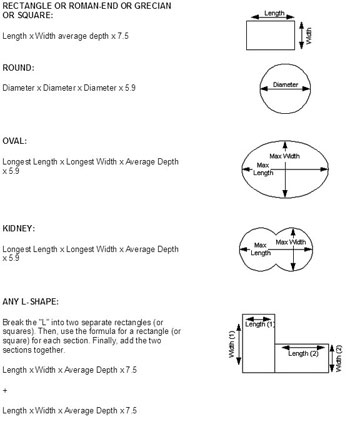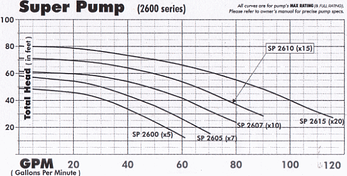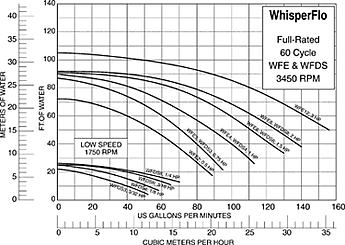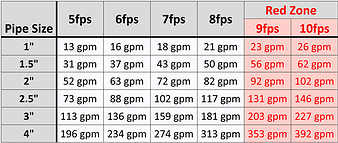The majority of Swimming Pools built over the years are plumbed incorrectly. We tend to get the following complaints from existing pool owners:
- My pump is too loud
- My pump is always too hot
- No matter how long I run my pump, my pool is never clear
- I keep having to replace my pump
unfortunately once your pool is built it is a little hard to correct the plumbing. We have also found that the pumps are usually over sized for the pool.
This article is being written to help with proper pipe sizing before the pool is built. Now you may ask "how do I know if my pool will be plumbed properly"? It is best to do your homework first before you hire the contractor to build your pool. The first step of proper pool plumbing is to determine the size and depth of the pool that you want built. Once you know this information you will need to calculate the number gallons your pool will hold. For a standard pool the following is the standard formula: Width X Length X Average Depth X 7.5 = Total Gallons.
 The average size pool we sell is a 16' X 32' Rectangle pool that is 6 feet deep on one end and 3 feet deep on the other end. The total gallons of water is 17,280. For proper circulation of water, it is best to filter the total gallons of water every 6 hours. Our next step is to determine how many gallons of water is needed per minute to turn over the pool every 6 hours. We take the total gallons of water: 17,280 divide by 6 hours = 2880 divide by 60 minutes in a hour = 48 gallons per minute. So you will need a pump that will produce 48 gallons per minute to properly circulate your water.
The average size pool we sell is a 16' X 32' Rectangle pool that is 6 feet deep on one end and 3 feet deep on the other end. The total gallons of water is 17,280. For proper circulation of water, it is best to filter the total gallons of water every 6 hours. Our next step is to determine how many gallons of water is needed per minute to turn over the pool every 6 hours. We take the total gallons of water: 17,280 divide by 6 hours = 2880 divide by 60 minutes in a hour = 48 gallons per minute. So you will need a pump that will produce 48 gallons per minute to properly circulate your water.
This next part can get a little tricky. Not only does your pool plumbing have to be able to properly flow 48 gallons of water for proper turnover it must also be able to accommodate the gallons per minute that the properly sized pool pump will produce. it is not always easy to purchase a pump that will produce the exact gallons per minute required. There are variable speed pumps that have this capability, but most of the time a properly sized pump is your best value. In order to determine the proper sized pump we must look at the pump manufactures pump curves . Most properly plumbed pools will produce 40 feet of Total Dynamic Head (TDH) this is the amount of resistance produced by the plumbing. We have two pump curve charts below: The first one is for a typical Hayward Super Pump. In order to move 48 gallons per minute at 40 TDH we would need at least a 1 horsepower pump. This pump would actually produce just over 60 gallons per minute.
. Most properly plumbed pools will produce 40 feet of Total Dynamic Head (TDH) this is the amount of resistance produced by the plumbing. We have two pump curve charts below: The first one is for a typical Hayward Super Pump. In order to move 48 gallons per minute at 40 TDH we would need at least a 1 horsepower pump. This pump would actually produce just over 60 gallons per minute. The next pump we will look at is the Pentair Whisper-flo Pump. With this pump we will need only a 1/2 hp pump to produce a minimum of 48 gallons per minute (gpm). This pump will produce about 66 gallons per minute at 40 feet of TDH. With this example bigger is definetly not always better when it comes to pumps. As you can see we can get more gallons per minute from the second pump than from the first pump.
The next pump we will look at is the Pentair Whisper-flo Pump. With this pump we will need only a 1/2 hp pump to produce a minimum of 48 gallons per minute (gpm). This pump will produce about 66 gallons per minute at 40 feet of TDH. With this example bigger is definetly not always better when it comes to pumps. As you can see we can get more gallons per minute from the second pump than from the first pump.
Now it is time to size our plumbing. According to the Association of Pool and Spa Professionals (APSP) and the Virginia Graeme Baker Act (VGB) which is now a federal law. It is required to have no more than 6 feet per second (fps) of water traveling thorough any suction line, and no more than 8 feet per second (fps) on any return line (except for certain water features- such as waterfalls).  According to the Chart below, for proper plumbing on a suction line we would need a minimum of 2.5" plumbing. On a return line we would need a minimum of 2" plumbing. Most high end pool builders and Engineers recommend sizing your plumbing for under 5 feet per second on the suction line, to make sure that you do not exceed the maximum feet per second. The slower the water travels through the pipe the easier the pump will work. This will return the following benefits: Quieter pump operation, Longer Pump Life, Better Energy Efficiency, and a Cleaner Pool. For the best energy efficiency it is recommend that if a 1 horsepower or more pump is required for proper turnover that you use a Variable Speed Pump. This pump should be operated at a lower speed for 24 hours a day. When you operate you pool pump 24 hours a day at a lower speed, you will use less energy.
According to the Chart below, for proper plumbing on a suction line we would need a minimum of 2.5" plumbing. On a return line we would need a minimum of 2" plumbing. Most high end pool builders and Engineers recommend sizing your plumbing for under 5 feet per second on the suction line, to make sure that you do not exceed the maximum feet per second. The slower the water travels through the pipe the easier the pump will work. This will return the following benefits: Quieter pump operation, Longer Pump Life, Better Energy Efficiency, and a Cleaner Pool. For the best energy efficiency it is recommend that if a 1 horsepower or more pump is required for proper turnover that you use a Variable Speed Pump. This pump should be operated at a lower speed for 24 hours a day. When you operate you pool pump 24 hours a day at a lower speed, you will use less energy.





